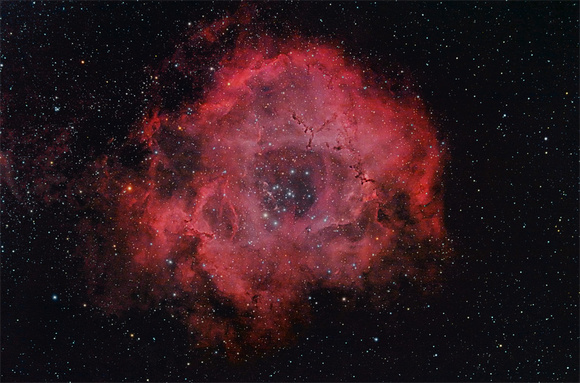Taken on Martin Luther King Jr.'s birthday and dedicated to him. His faith, hope and courage spread like the petals of a rose to unite a nation.
Date: 1/18/2010, 1/27/2010
Target: NGC2244 - The Rosette Nebula
Telescope: Vixen ED80Sf w/ WO 0.8x FR/FF
Camera: Canon 40D (modified)
Filter: Hutech IDAS LPS, Astronomik 12nm Ha EOS Clip
Exposures:
37x300s (3.0h) @ ISO800 RGB
21x600s (3.5h) @ ISO800 Ha (used as luminance)
Framing: North is up
Start Temp: 34F
End Temp: 28F
Location: Mocksville, NC
Seeing: 3/5
Transparency: 4/5
Start Time: 8:00PM
End Time: 12:00AM
Captured using Nebulosity, stacked using DeepSkyStacker, processed in Photoshop.
Anacortes Telescope and Wild Bird Picture of the Day April 2, 2010Featured on Vixen Optics ED80Sf Product Page (original)From
Wikipedia:
The
Rosette Nebula is a large, circular
H II region located near one end of a giant molecular cloud in the
Monoceros region of the
Milky Way Galaxy. The
open cluster NGC 2244 is closely associated with the nebulosity, the
stars of the cluster having been formed from the nebula's
matter.
The complex has the following
NGC designations:
- NGC 2237 - Part of the nebulous region (Usually used to denote whole nebula)
- NGC 2238 - Part of the nebulous region
- NGC 2239 - Part of the nebulous region (Discovered by John Herschel)
- NGC 2244 - The open cluster within the nebula (Discovered by John Flamsteed in 1690)
- NGC 2246 - Part of the nebulous region
The cluster and nebula lie at a distance of some 5,200
light years from
Earth (although estimates of the distance vary considerably) and measure roughly 130 light years in diameter. The
radiation from the young stars excite the
atoms in the nebula, causing them to emit radiation themselves producing the emission nebula we see. The
mass of the nebula is estimated to be around 10,000
solar masses.


